Effect of Acoustic Treatment and Table Dividers on Diners’ Experience in a Montréal Restaurant
Abstract
This study investigates the effect of acoustic treatment in an upscale restaurant in Montreal (at Institut du Tourisme et Hôtellerie du Québec). A questionnaire was administered to a total of 225 diners before (N = 140) and after (N = 85) the installation of acoustic panels on the ceiling of the dining room. Participants were asked to rate their overall experience, the soundscape of the restaurant, as well as their vocal and listening effort. Additionally, as this work was conducted during the COVID-19 pandemic, we explored the influence of transparent acrylic dividers between tables. Two-way MANOVAs were conducted to investigate the effect of acoustic treatment (before/after) and dividers (with/without). We observed significant effects of both interventions on vocal and listening effort, as well as a significant effect of acoustic treatment on satisfaction and soundscape judgments. Specifically, the presence of acoustic treatment improved overall satisfaction and soundscape judgments (rated as more pleasant and calmer) while reducing perceived vocal and listening effort, but without affecting the visual experience. On the other hand, the presence of table dividers resulted in worse soundscape judgments and increased vocal and listening effort. On theoretical grounds, the results highlight the potential of acoustic treatment to enhance diners’ experience as well as the detrimental effect of table dividers on acoustic comfort. On methodological grounds, the proposed questionnaire could be used to assess acoustic interventions from the user perspective in a wide range of settings.Additional Files
Published
How to Cite
Issue
Section
License
Author Licensing Addendum
This Licensing Addendum ("Addendum") is entered into between the undersigned Author(s) and Canadian Acoustics journal published by the Canadian Acoustical Association (hereinafter referred to as the "Publisher"). The Author(s) and the Publisher agree as follows:
-
Retained Rights: The Author(s) retain(s) the following rights:
- The right to reproduce, distribute, and publicly display the Work on the Author's personal website or the website of the Author's institution.
- The right to use the Work in the Author's teaching activities and presentations.
- The right to include the Work in a compilation for the Author's personal use, not for sale.
-
Grant of License: The Author(s) grant(s) to the Publisher a worldwide exclusive license to publish, reproduce, distribute, and display the Work in Canadian Acoustics and any other formats and media deemed appropriate by the Publisher.
-
Attribution: The Publisher agrees to include proper attribution to the Author(s) in all publications and reproductions of the Work.
-
No Conflict: This Addendum is intended to be in harmony with, and not in conflict with, the terms and conditions of the original agreement entered into between the Author(s) and the Publisher.
-
Copyright Clause: Copyright on articles is held by the Author(s). The corresponding Author has the right to grant on behalf of all Authors and does grant on behalf of all Authors, a worldwide exclusive license to the Publisher and its licensees in perpetuity, in all forms, formats, and media (whether known now or created in the future), including but not limited to the rights to publish, reproduce, distribute, display, store, translate, create adaptations, reprints, include within collections, and create summaries, extracts, and/or abstracts of the Contribution.


